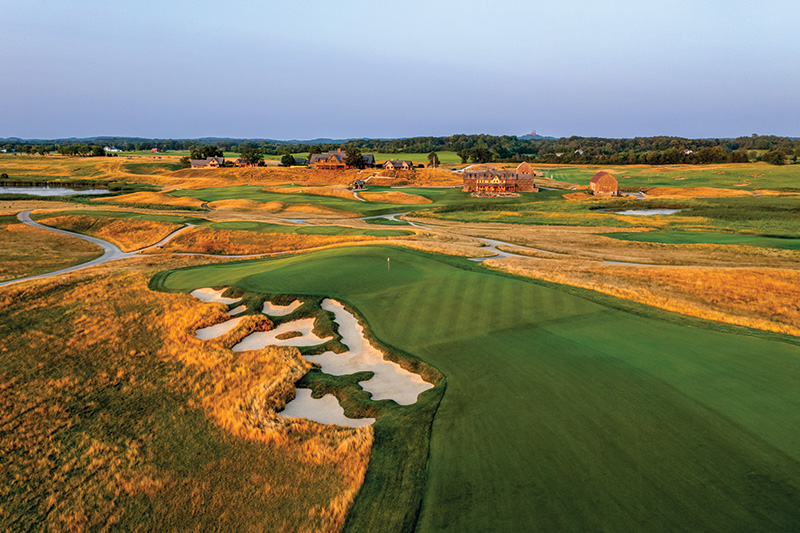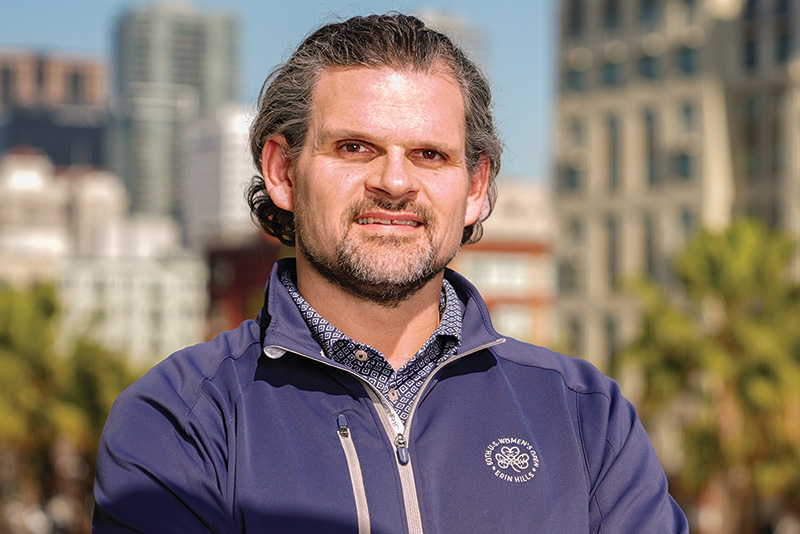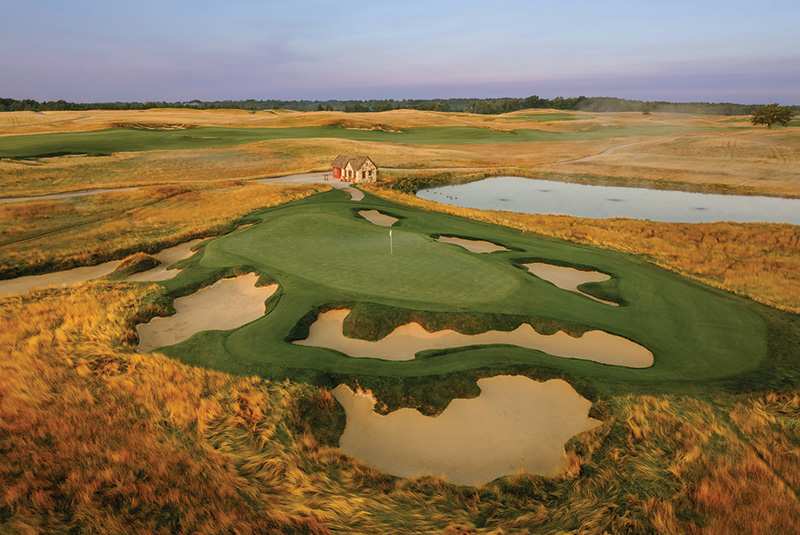
Erin Hills will host its second U.S. Women's Open May 29-June 1. Photo courtesy of the USGA
Two weeks.
In the grand scheme of things, two weeks — 14 days, 336 hours, a fortnight — isn’t much, but when it comes to preparing a northern United States golf course for a major tournament, well, two weeks can be huge.
“You wouldn’t think two weeks would make much of a difference,” says Zach Reineking, GCSAA Class A senior director of course maintenance for Erin Hills Golf Course in Erin, Wis., “but it’s actually pretty significant. We see the most change to our property in the month of May.”
Reineking, a 22-year association member, knows what he’s talking about. After joining the Erin Hills crew as an assistant superintendent during its construction, Reineking has been around for all of its springs — including the one in 2017 that sparked all that reflection on the importance of two weeks.
When Erin Hills had its big coming-out party, hosting, at the precocious age of 11, the 2017 U.S. Open, the red-letter dates circled on the calendar were June 15-18. Two crucial weeks shy of eight years later, the USGA will return to Erin Hills for the U.S. Women’s Open Presented by Ally, May 29-June 1.
Not that Reineking is worried, because that 2017 U.S. Open taught him and his seasoned crew a few things that apply as much to major-tournament prep as the every-day approach to tending to one of the most decorated public golf courses in the country.
“Hosting such an event is an honor,” Reineking says. “What we learned in the process is, you have to be able to expect everything and anything. That event was two weeks later than the U.S. Women’s Open will be, but we usually don’t get extreme temperatures then. In 2017, we got 2-3 inches of rain the Tuesday before the championship started, then the temperatures ramped up to the low 90s, with high humidity. You have to get accustomed to expect anything. We’ve seen frost at the end of May, and we’ve also seen 85 degrees at the end of May, so we’re trying to be prepared for any conditions that are presented to us.”

Erin Hills Golf Course’s senior director of course maintenance, Zach Reineking says time will tell if the weather will warm quickly enough to provide the stark contrast between managed surfaces and natives that are a course signature. Photo by Darren Carroll
No pesky golfers getting in the way
As in 2017, those Open preparations began well in advance of the actual run-up. They ramped up in earnest last Oct. 18, when the course closed for play — roughly two weeks earlier than most seasons — and will remain closed until after the USWO.
“It’s a huge advantage for us,” Reineking says. “We’re so appreciative of the ownership and their commitment to hosting USGA events. By closing early and not being open, that allows us to deal with any divots we have on the par 3s. We’re able to get healed back in. The greens don’t have any traffic. There’s no ball marks. It allows us to really dial in the golf course and make it as good as it possibly can be for the event. Not having golfers out here allows us the flexibility to do what we need to do without having to sneak around play. Without the confinement of working around play, it really gives us the flexibility to script our plan.”
That plan really kicked in last fall with aggressive cultural practices to help Erin Hills weather the Wisconsin weather.
“We put a lot of effort in during the fall to try to mitigate any issues,” Reineking says. “We did a lot of top dressing of approaches and fairways and tees.”
The crew also deployed covers for the course’s greens — a not-uncommon practice for that part of the country that Reineking refers to as a “safety blanket.”
“We sit exposed,” he says. “We don’t have a lot of trees with high winds. The last several years, we’ve had highly variable conditions in the wintertime — nothing out of the ordinary, but we haven’t had consistent temperatures or precipitation. This winter, we had probably average temperatures, but it was dry. We had the driest January on record for the state of Wisconsin, and there are some concerns that go with that. We have concerns about desiccation for any turf that’s exposed to the elements.
“Going into March, we had some apprehension about how we would come out of winter. Now (early April), it’s starting to warm up, but it’s really variable. It’s odd. Last week, on Friday it was 72, then we got snow on Sunday. Over 48 hours, we had a 40-degree temperature swing. Everything is slowly breaking dormancy. Our greens look great because we had the covers on. We pulled the covers off, and they looked great. The fairways … every day, they get more green coloration.”
About those fairways …
Erin Hills GC has undergone a few changes, some more subtle than others, since the 2017 U.S. Open.
The subtle: Teeing areas have been expanded, which should allow the USGA to “really dial in” desired yardages depending on wind and course conditions. Also, all bunkers were renovated, returned to their original size, repaired, constructed with the Better Billy Bunker method and re-sanded.
Not so subtly, back in 2020, the decision was made to replace Erin Hills’ signature fescue-forward fairways with creeping bentgrass.
“Unfortunately, we have heavy soils,” Reineking says. “We had problems with drainage in keeping those fine fescues in good condition. We had Poa, fine fescues — it was a mix of grasses, and it was a challenge to make sure all of those grasses performed well.”
The conversion followed a novel script. Rather than kill off the old fairways and reseed — a catastrophic approach that can cause a course to be closed for a year or more — the crew concocted a plan to overseed instead.
The offending Poa/fescue Frankengrass was scalped, then hit with plant growth regulators. Then, the fairways were heavily overseeded with the blend of Flagstick and 007 bentgrasses and heavily topdressed. The 1-2 punch knocked the old turfgrass down and gave the bentgrass a competitive advantage to take over. The course was closed only about a week.
“It was really unconventional,” says John Jacques, associate golf course superintendent and 17-year GCSAA member who has been at Erin Hills since 2010. “Fortunately, we also had a really great stretch of weather, with temperatures in the 90s and a couple of rainstorms. When you’re trying to grow bentgrass and you get 90-degree days, it can germinate in three, four days. And with the other stuff so regulated, we gave it a chance to outcompete.”
Jacques acknowledges there was a risk, though the team did a small-scale test beforehand. The USGA was consulted, since Erin Hills was on the slate to host the 2022 U.S. Mid-Amateur in short order.
The re-grassing was not, however, a concession for any upcoming USGA event so much as an acknowledgment that the fescue was struggling.
“Bentgrass is just more playable earlier on than fescue fairways,” Jacques says. “Fescue and heavy, clay soils don’t get along too well. This is just a cleaner, more consistent playing surface, and we’re able to do more on a cultural-practice level. We’re able to topdress more often, where we had to baby the fescue along.”

In addition to re-grassing of fairways from a fescue mix to bentgrass in 2020, all bunkers have been renovated since Erin Hills hosted the 2017 U.S. Open. Photo courtesy of the USGA
All for Erin
Reineking and Jacques are the only long-timers on staff. In fact, in terms of lifetime percentages, they’re relative newbies.
Senior assistant superintendent Bryan Fenney started working at Erin Hills when he was in middle school. In fact, when he first started, he didn’t have a driver’s license, so his school bus dropped him off at the course so he could work after school. Fenney recalls working from 3 p.m. until dark during grow-in, plus some weekends work. After taking the winter off, he’d return to the routine in the spring, then work full time through the summer.
“It’s my home course, my homeland” says Fenney, a 13-year GCSAA member who has spent part of 13 years at Erin Hills, intertwined with school at Wisconsin-Madison, an internship at Erin Hills and assistantships at a few other area courses before he returned in 2019. “Erin’s my hometown. Having a world-class golf course here means a lot to me.”
Fenney wasn’t on staff when that course hosted the U.S. Open, though he did serve as a volunteer then.
It’s no wonder, then, why this USWO means so much to him.
“It’s a chance for us to show how great the area is, to show how much work and effort the people from Erin put in,” he says. “People from all across the U.S. came to this town to work here. It’s a special place. The property, the topography — the people from Erin understand how special and important this town is. When people come here, they can’t wait to come back. They can feel just how special the area is, and we can’t wait to show it off.”
Andrew Hartsock (ahartsock@gcsaa.org) is GCM’s editor-in-chief.